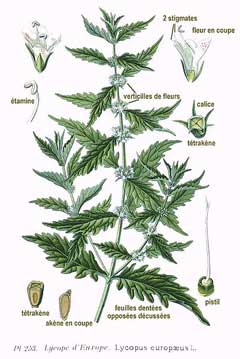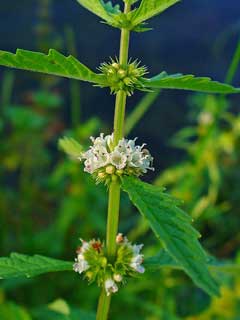 |
|
http://commons.wikimedia.org/wiki/File:253_Lycopus_europaeus_L.jpg |
 |
| http://commons.wikimedia.org/wiki/User:Llez |
Translate this page:
Summary
Physical Characteristics

 Lycopus europaeus is a PERENNIAL growing to 1 m (3ft 3in).
Lycopus europaeus is a PERENNIAL growing to 1 m (3ft 3in).
See above for USDA hardiness. It is hardy to UK zone 5. It is in flower from June to September, and the seeds ripen from August to October. The species is hermaphrodite (has both male and female organs) and is pollinated by Bees, flies. The plant is self-fertile.
Suitable for: light (sandy), medium (loamy) and heavy (clay) soils. Suitable pH: mildly acid, neutral and basic (mildly alkaline) soils. It can grow in semi-shade (light woodland) or no shade. It prefers moist or wet soil and can grow in water.
UK Hardiness Map
US Hardiness Map
Synonyms
Lycopus alboroseus. Lycopus albus. Lycopus aquaticus. Lycopus decrescens
Plant Habitats
Pond; Bog Garden;
Edible Uses
Edible Parts: Root
Edible Uses:
Root - raw or cooked. A famine food, it is only used when all else fails[179].
References More on Edible Uses
Medicinal Uses
Plants For A Future can not take any responsibility for any adverse effects from the use of plants. Always seek advice from a professional before using a plant medicinally.
Astringent Miscellany Poultice Sedative
The fresh or dried flowering herb is astringent and sedative[4]. It inhibits iodine conversion in the thyroid gland and is used in the treatment of hyperthyroidism and related disorders[9]. The whole plant is used as an astringent, hypoglycaemic, mild narcotic and mild sedative[4, 238]. It also slows and strengthens heart contractions[238]. The plant has been shown to be of value in the treatment of hyperthyroidism[9, 238], it is also used in the treatment of coughs, bleeding from the lungs and consumption, excessive menstruation etc[4, 238]. The leaves are applied as a poultice to cleanse foul wounds[240]. This remedy should not be prescribed for pregnant women or patients with hypothyroidism[238]. The plant is harvested as flowering begins and can be use fresh or dried, in an infusion or as a tincture[4, 238]. Current uses are predominantly for increased activity of the thyroid gland and for premenstrual syndrome symptoms such as breast pain [301]. The German Commission E Monographs, a therapeutic guide to herbal medicine, approve Lycopus for nervousness and premenstrual syndrome (see [302] for critics of commission E).
References More on Medicinal Uses
The Bookshop: Edible Plant Books
Our Latest books on Perennial Plants For Food Forests and Permaculture Gardens in paperback or digital formats.

Edible Tropical Plants
Food Forest Plants for Hotter Conditions: 250+ Plants For Tropical Food Forests & Permaculture Gardens.
More

Edible Temperate Plants
Plants for Your Food Forest: 500 Plants for Temperate Food Forests & Permaculture Gardens.
More

More Books
PFAF have eight books available in paperback and digital formats. Browse the shop for more information.
Shop Now
Other Uses
Dye Miscellany
A black dye is obtained from the plant[4, 100]. It is said to give a permanent colour and was also used by gypsies in order to darken the skin[4].
Special Uses
References More on Other Uses
Cultivation details
Tolerates most soil types so long as they are wet. Grows well in shallow water. Succeeds in sun or shade.
References Carbon Farming Information and Carbon Sequestration Information
Temperature Converter
Type a value in the Celsius field to convert the value to Fahrenheit:
Fahrenheit:
The PFAF Bookshop
Plants For A Future have a number of books available in paperback and digital form. Book titles include Edible Plants, Edible Perennials, Edible Trees,Edible Shrubs, Woodland Gardening, and Temperate Food Forest Plants. Our new book is Food Forest Plants For Hotter Conditions (Tropical and Sub-Tropical).
Shop Now
Plant Propagation
Seed - sow spring or autumn in a cold frame[238]. Prick out the seedlings into individual pots when they are large enough to handle and grow them on in the greenhouse for their first year. Plant them out into their permanent positions in early summer. Division in spring or autumn[238]. Larger clumps can be replanted direct into their permanent positions, though it is best to pot up smaller clumps and grow them on in a cold frame until they are rooting well. Plant them out in the spring.
Other Names
If available other names are mentioned here
Native Range
TEMPERATE ASIA: Afghanistan, Iran, Iraq, Syria (west), Turkey, Russian Federation-Ciscaucasia (Ciscaucasia), Armenia, Azerbaijan, Georgia, Russian Federation (Dagestan), Russian Federation-Western Siberia (Western Siberia), Russian Federation-Eastern Siberia (Eastern Siberia), Kazakhstan, Kyrgyzstan, Tajikistan, Uzbekistan, China (Hebei Sheng, Shaanxi Sheng, Xinjiang Uygur Zizhiqu), Japan TROPICAL ASIA: Pakistan EUROPE: Denmark, United Kingdom, Norway, Sweden, Czechoslovakia, Austria, Belgium, Switzerland, Germany, Hungary, Netherlands, Poland, Russian Federation (European part), Belarus, Estonia, Lithuania, Latvia, Moldova, Ukraine, Former Yugoslavia, Albania, Bulgaria, Greece, Italy, Romania, Spain, France, Portugal
Weed Potential
Right plant wrong place. We are currently updating this section.
Please note that a plant may be invasive in one area but may not in your area so it's worth checking.
Conservation Status
IUCN Red List of Threatened Plants Status :

Growth: S = slow M = medium F = fast. Soil: L = light (sandy) M = medium H = heavy (clay). pH: A = acid N = neutral B = basic (alkaline). Shade: F = full shade S = semi-shade N = no shade. Moisture: D = dry M = Moist We = wet Wa = water.
Now available:
Food Forest Plants for Mediterranean Conditions
350+ Perennial Plants For Mediterranean and Drier Food Forests and Permaculture Gardens.
[Paperback and eBook]
This is the third in Plants For A Future's series of plant guides for food forests tailored to
specific climate zones. Following volumes on temperate and tropical ecosystems, this book focuses
on species suited to Mediterranean conditions—regions with hot, dry summers and cool, wet winters,
often facing the added challenge of climate change.
Read More
Expert comment
Author
L.
Botanical References
17200
Links / References
For a list of references used on this page please go here
Readers comment
© 2010, Plants For A Future. Plants For A Future is a charitable company limited by guarantee, registered in England and Wales. Charity No. 1057719, Company No. 3204567.